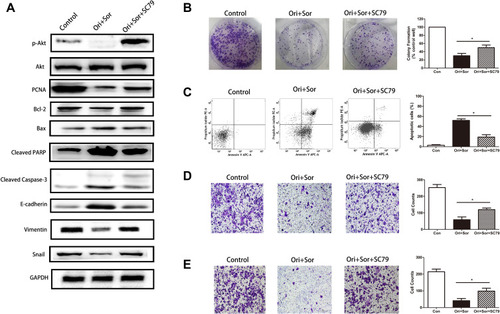Li X, Chen W, Liu K, et al. Cancer Manag Res. 2020;12:8081–8091
The authors have advised (on page 8088) is incorrect due to layout negligence during figure disposal. The correct Figure is shown below:
Figure 5 The Akt pathway played an important role in the anticancer effect of combined oridonin and sorafenib treatment. (A) SC79 was used to enhance the phosphorylation of Akt after cotreatment with oridonin and sorafenib, which partially restored the levels of proteins associated with proliferation, apoptosis and EMT. (B) Colony formation assays showed that SC79 treatment restored the proliferation that was inhibited by combined oridonin and sorafenib treatment. (C) Flow cytometry showed that the enhanced apoptosis induction caused by combined oridonin and sorafenib treatment was mitigated by SC79 treatment. (D and E) Reactivation of AKT after SC79 treatment restored cell migration and invasion that had been impaired by cotreatment with the two drugs. (The data represent the mean ± SD of three independent experiments. *Indicates p<0.05 compared with the combination group; Ori + Sor indicates combined oridonin and sorafenib treatment).

